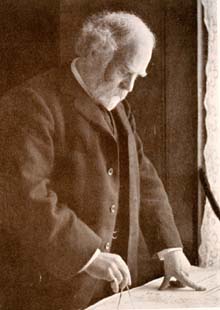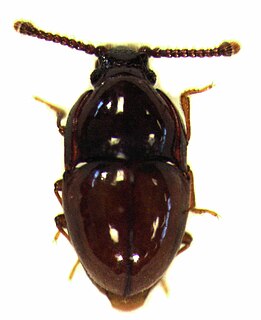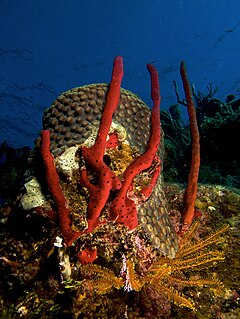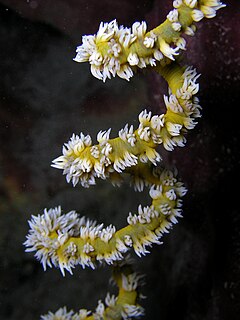
Sir John Murray was a pioneering Canadian-born British oceanographer, marine biologist and limnologist. He is considered to be the father of modern oceanography.

Tube-dwelling anemones or ceriantharians look very similar to sea anemones but belong to an entirely different subclass of anthozoans. They are solitary, living buried in soft sediments. Tube anemones live inside and can withdraw into tubes, which are composed of a fibrous material made from secreted mucus and threads of nematocyst-like organelles known as ptychocysts. Within the tubes of these ceriantharians, more than one polyp is present, which is an exceptional trait because species that create tube systems usually contain only one polyp per tube. Ceriantharians were formerly classified in the taxon Ceriantipatharia along with the black corals but have since been moved to their own subclass, Ceriantharia.

Philautus is a genus of shrub frogs in the family Rhacophoridae from Asia. Some species in this genus are now considered extinct by IUCN, while others are widespread and abundant. The taxonomy of the group is unclear, with many poorly described species.

Gracillariidae is an important family of insects in the order Lepidoptera and the principal family of leaf miners that includes several economic, horticultural or recently invasive pest species such as the horse-chestnut leaf miner, Cameraria ohridella.

Cryptophagidae is a family of beetles with representatives found in all biogeographic realms. Members of this family are commonly called silken fungus beetles and both adults and larvae appear to feed exclusively on fungi although in a wide variety of habitats and situations, such as rotting wood and shed animal fur and feathers. These beetles vary from about 1 to 11 millimeters long, and usually have an oval body shape with a slight "waist".

Eumops is a genus of bats in the family Molossidae. A total of 17 species of this genus have been described. The name "Eumops" comes from the Greek prefix "Eu-", meaning "good" or "true," and the Malayan word "mops," which means bat.
Nephelomys keaysi, also known as Keays's oryzomys or Keays's rice rat, is a species of rodent in the genus Nephelomys of family Cricetidae. It is found from southeastern Peru to northern Bolivia on the eastern slope of the Andes in Yungas humid forest at altitudes of 1000 to 2600 m. Although its continued existence is not in serious danger and it is listed as "least concern", destruction of its habitat may pose a threat to some populations.

Tethya is a genus of sea sponges belonging to the family Tethyidae. Members of this genus all have a spherical body form and some are known to be able to move at speeds of between 1 and 4 mm per day.

Cliona is a genus of demosponges in the family Clionaidae. It contains about eighty described species.
Thoosa is a genus of sea sponges in the family Thoosidae. This genus is known for boring holes in corals. It contains sixteen described species.

Amphimedon is a genus of sponges with over 60 described species. In 2009, Amphimedon queenslandica was the first species of sponge to have its genome sequenced.

Eudendrium is a large genus of hydroids (Hydrozoa), one of two in the family Eudendriidae. These animals are marine cnidarias in the family Eudendriidae.

Macrorhynchia is a genus of hydroids in the family Aglaopheniidae.

Turritopsis nutricula is a small hydrozoan that once reaching adulthood, can transfer its cells back to childhood. This adaptive trait likely evolved in order to extend the life of the individual. Several different species of the genus Turritopsis were formerly classified as T. nutricula, including the "immortal jellyfish" which is now classified as T. dohrnii.

Cirrhipathes is a genus of black coral from the family Antipathidae. Coral species in this genus are commonly known as whip or wire corals because they often exhibit a twisted or coiled morphology. In addition to their colorful appearance, with colors ranging from yellow to red passing through blue and green, these species possess a dark skeleton that is characteristic to every black coral.

Mycale is a genus of demosponge with 240 recognised species in 11 subgenera. It has been a large genus with multiple subdivisions since it was first described in 1867.

Acanthella is a genus of sponges in the family Dictyonellidae, which was first described in 1862 by Eduard Oscar Schmidt. The type species is Acanthella acuta Schmidt, 1862.
Chondropsis is a genus of sponges belonging to the family Chondropsidae.
Perarella is a genus of hydrozoans belonging to the family Cytaeididae.

Zanclea is a genus of hydrozoans belonging to the family Zancleidae.















